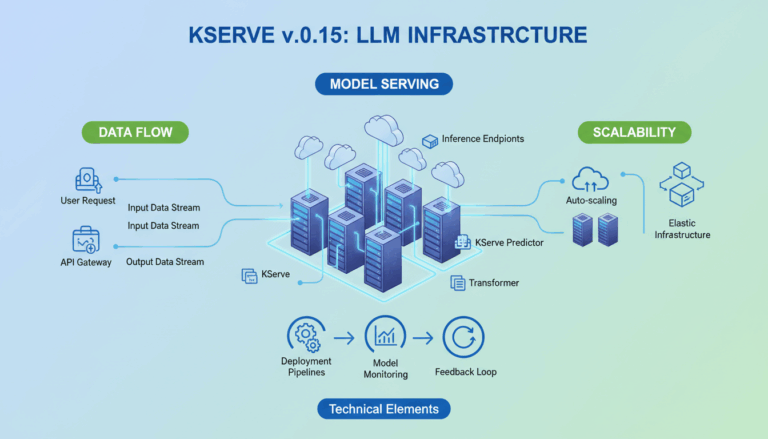Introduction to Large Language Models (LLMs) in Cybersecurity
Large Language Models (LLMs) have emerged as a transformative force within the realm of cybersecurity. These models, exemplified by systems like GPT-3 and beyond, are neural network architectures capable of understanding and generating human-like text. Built upon vast datasets and extensive machine learning techniques, LLMs possess a remarkable ability to parse complex language patterns, thereby offering innovative solutions to some of the pervasive challenges in cybersecurity.
One significant area where LLMs shine is in threat detection and response. Traditional cybersecurity systems often falter with the ever-evolving nature of cyber threats. LLMs, however, are adept at identifying anomalies within network traffic by understanding the nuanced semantics of communication between actors in an environment. For example, they can scrutinize logs and communications to detect subtle indicators of phishing and spear-phishing attempts, which rely heavily on language patterns.
Furthermore, LLMs empower cybersecurity actors in vulnerability assessment and management. They can automate the scanning of code repositories to find potential security loopholes by leveraging their vast understanding of coding languages and vulnerabilities described in textual data. The models can also predict and suggest patch implementations, addressing vulnerabilities faster and more efficiently than manual processes alone.
Another fascinating application lies in the domain of security training. LLMs can generate realistic and varied phishing email scenarios, allowing cybersecurity personnel to undergo rigorous training in identifying such threats. This dynamic training adaptation is crucial in keeping the workforce prepared for new types of phishing attempts that are continuously invented by cybercriminals.
Moreover, LLMs play a vital role in improving incident response times. By automating the initial analysis of security alerts and incidents, they help prioritize threats based on their potential impact, ensuring that human experts can focus on critical tasks rather than being overwhelmed by data. Their ability to contextualize alerts in real time by relating them to known patterns and events offers a new level of sophistication in cybersecurity operations.
Additionally, LLMs contribute to enhancing user authentication processes. By understanding user behavior and language use patterns, these models can contribute to detecting anomalies that might signify unauthorized access attempts. They further enable more secure, personalized, and context-aware authentication challenges, minimizing the risk of breaches.
Despite the promising capabilities of LLMs, it’s essential to acknowledge the ethical and privacy concerns associated with their deployment. The models can inadvertently propagate biases present in their training data, which might lead to false positives in threat detection or unfair user assessments. As such, continuous evaluation and fine-tuning of LLMs are necessary to ensure their efficacy and fairness in cybersecurity applications.
Overall, the integration of LLMs into cybersecurity represents a paradigm shift, offering both opportunities and challenges that require careful navigation. By leveraging these advanced models, cybersecurity practitioners can significantly elevate their capabilities in threat detection, response, and prevention, thus safeguarding digital assets more effectively.
Enhancing Threat Detection and Response with LLMs
Incorporating Large Language Models (LLMs) into cybersecurity frameworks markedly enhances threat detection and response capabilities. These models excel in processing and interpreting the vast amounts of data necessary for identifying and addressing security threats in their nascent stages. By doing so, they significantly bolster an organization’s ability to safeguard its digital assets.
LLMs, due to their intricate natural language processing capabilities, are highly proficient at sifting through complex datasets to identify patterns indicative of potential security threats. This capability is crucial when dealing with the nuanced and diverse nature of cyber threats. For example, LLMs can analyze network traffic logs and communication streams for irregular patterns or subtle deviations in language that might signal a phishing attempt or a data breach in progress.
Moreover, LLMs enhance the detection of insider threats—one of the more challenging aspects of cybersecurity. Traditional methods may overlook context-specific anomalies because they lack the sophistication to interpret behaviors outside predefined parameters. In contrast, LLMs can analyze employee communications within an organizational network, discerning unusual deviations in language or tone that might suggest malicious intent. This kind of granular analysis was previously unattainable through conventional means.
In response operations, LLMs streamline the incident response process by providing real-time contextual analysis of alerts. When integrated into Security Information and Event Management (SIEM) systems, LLMs can prioritize threats based not only on severity but also on the potential impact, allowing cybersecurity professionals to allocate resources more effectively. This prioritization is pivotal in environments overwhelmed by constant streams of alerts requiring judgment calls on where to direct immediate attention.
LLMs also facilitate more efficient threat intelligence sharing by automating the extraction and dissemination of critical threat information to relevant stakeholders. By parsing threat intelligence feeds, LLMs can enrich datasets with contextual information, making them actionable for cybersecurity teams across different organizations. This interoperability in threat data ensures a more coordinated and speedy defensive response to emerging threats.
Additionally, the adaptability of LLMs allows them to keep pace with the fast-evolving cybersecurity landscape. Cyber threats are becoming increasingly sophisticated, often utilizing enhanced social engineering tactics. LLMs aid in adapting to these changes by refining their models with fresh data and improving their threat identification algorithms based on new threat landscapes.
Finally, LLMs play a vital role in predictive analysis. By considering historical threat data and current pattern recognition, these models can foresee potential cyber threats and suggest preventive measures before they manifest into full-fledged problems. This predictive capability is integral in developing proactive cybersecurity strategies, shifting from reactive measures to anticipatory defense.
Through their advanced analytical abilities, LLMs not only enhance traditional cybersecurity methods but also introduce novel strategies to preempt, identify, and respond to threats effectively. The utilization of LLMs in cybersecurity frameworks thus represents a significant advancement in the ongoing battle against cybercrime, enhancing both security efficiency and efficacy.
Automating Vulnerability Assessment and Management
Large Language Models (LLMs) are revolutionizing the field of cybersecurity by automating vulnerability assessment and management through advanced natural language processing and machine learning capabilities. These models are adept at analyzing vast amounts of data, including codebases and documentation, to identify potential security vulnerabilities efficiently and accurately.
Traditionally, vulnerability assessment involved manual processes where cybersecurity professionals painstakingly reviewed code and system configurations to spot weak points. This labor-intensive method often led to delayed vulnerability identification and a backlog of security tasks. With the advent of LLMs, this landscape is rapidly transforming.
LLMs automate the initial stages of vulnerability assessment by scanning through code repositories and software frameworks using their extensive understanding of programming syntax and common vulnerabilities. For instance, they can identify SQL injection vulnerabilities by recognizing suspicious patterns in database queries. Their ability to process and interpret code from various programming languages allows them to highlight areas of concern automatically.
Furthermore, these models are capable of cross-referencing identified vulnerabilities with publicly available databases such as the Common Vulnerabilities and Exposures (CVE) list. By doing this, LLMs can not only confirm the presence of known vulnerabilities but also prioritize them based on severity and exploitability. This prioritization is facilitated by their ability to contextualize vulnerabilities within the specific infrastructure, providing informed recommendations for patching.
Another significant advantage offered by LLMs in vulnerability management is their predictive capabilities. By analyzing historical vulnerability data and current cyber threat landscapes, LLMs can forecast potential security flaws within specific systems or applications. This predictive insight enables organizations to fortify their defenses proactively, addressing potential issues before they are exploited by adversaries.
In operational contexts, LLMs integrate seamlessly with continuous integration and deployment (CI/CD) pipelines. As part of this integration, LLMs constantly monitor the code being pushed into production environments, providing real-time alerts and assessments. This approach helps in maintaining a secure development lifecycle (DevSecOps) where security checks are a continuous and automated part of the development process.
Moreover, LLMs enhance the process of remedial action by suggesting detailed, context-aware solutions for discovered vulnerabilities. For instance, upon identifying a flaw, LLMs can search existing literature and documentation to propose solutions derived from similar past occurrences. They can also facilitate communication among cybersecurity teams by generating concise summaries and technical reports regarding vulnerabilities and the suggested mitigation strategies.
Another aspect where LLMs contribute significantly is in reducing the expertise barrier for vulnerability assessment. By distilling complex security information into easy-to-understand language or providing step-by-step guidance, LLMs empower junior security analysts or developers to participate effectively in vulnerability management tasks. This democratization of security expertise enables organizations to enhance their overall security posture without relying solely on a limited pool of expert talent.
Finally, as organizations adopt LLMs, it is crucial to remain vigilant about potential biases and inaccuracies introduced by the language models themselves. Regular monitoring and fine-tuning of these models with updated datasets are essential to maintain their effectiveness while minimizing false positives or negatives.
Overall, the integration of LLMs into the realm of vulnerability assessment and management signifies a profound shift towards automation and intelligence-driven cybersecurity measures, enabling faster, more accurate identification and remediation of vulnerabilities across digital infrastructures.
LLMs in Phishing Detection and Social Engineering Defense
Large Language Models (LLMs) represent a breakthrough in detecting and defending against phishing attacks and social engineering tactics. These language-driven threats exploit human trust and social techniques to deceive individuals into divulging sensitive information, such as passwords or financial details. Historically, these attacks have been difficult to combat due to their reliance on subtle manipulations and evolving strategies. However, the advent of LLMs offers sophisticated tools to identify and counter such schemes by understanding the nuances of human language and behavior.
One of the primary advantages of LLMs in this domain is their ability to analyze and interpret the intent behind complex email communications. Traditional email filters might look for keyword patterns or sender information, but LLMs can delve deeper into the text’s context, assessing the overall tone and content to identify phishing attempts. This capability helps distinguish between legitimate and malicious communications with greater precision. For example, if an email requests sensitive information under the guise of an executive directive or emergency, LLMs can recognize the persuasive linguistic tactics often employed in phishing scams.
Furthermore, LLMs enhance automated phishing simulations, a critical component of security awareness training. By creating realistic email samples that mirror the tactics employed by cybercriminals, LLMs provide invaluable training resources for employees. These simulated environments help staff members practice recognizing and responding to phishing threats without the consequences of falling victim to an actual attack. The adaptability of LLMs ensures that the simulated emails remain relevant and challenging as phishing tactics evolve.
In addition to email analysis, LLMs play a crucial role in detecting social engineering attempts within broader communication channels, such as text messaging and voice calls. By processing transcripts or logs, LLMs can identify suspicious behavior patterns—such as urgency, fear appeals, or suggestion techniques—commonly utilized by social engineers to manipulate their targets. This kind of analysis aids in preemptively flagging or blocking potentially harmful interactions.
The predictive capabilities of LLMs also allow for proactive defense strategies by analyzing historical data and current trends in social engineering attacks. By understanding these patterns, organizations can implement preventative measures or alert systems that automatically notify security teams of possible vulnerabilities or targeted personnel. This foresight positions companies to defend against attacks before they reach their objectives.
Moreover, LLMs facilitate the development of intelligent chatbots or virtual assistants capable of interacting with customers and employees. These systems can provide real-time verification of suspicious inquiries, reducing the likelihood of successful social engineering by prompting additional verification or authentication checks. By mitigating the risk of unauthorized information disclosure, such tools add an additional layer of security.
The integration of LLMs with existing cybersecurity frameworks requires ongoing evaluation and refinement to ensure accurate and fair outcomes. This includes regular updates to the training data to capture emerging threats and developing strategies to address biases that could result in false positives or missed detections. Nevertheless, the potential for these models to transform defensive strategies against phishing and social engineering is immense, providing a multi-faceted approach that blends technological prowess with human-like understanding.
Through their advanced language processing abilities, LLMs not only enhance traditional defenses but also open new avenues for anticipating, identifying, and responding to phishing and social engineering tactics effectively. Deploying LLMs in the fight against these threats strengthens security protocols, ultimately securing sensitive data and maintaining organizational integrity.
Challenges and Risks of Integrating LLMs in Cybersecurity
Integrating Large Language Models (LLMs) into cybersecurity systems presents a spectrum of challenges and risks that organizations must navigate to harness their potential effectively and responsibly. The complexity and resource-intensive nature of these models can pose significant hurdles for their integration into existing cybersecurity frameworks.
One of the primary challenges revolves around the computational and infrastructural demands of LLMs. These models require substantial processing power and data storage, often necessitating specialized hardware and cloud services. Organizations must evaluate whether their existing infrastructure can support such requirements or if significant upgrades are needed. Scaling LLMs efficiently requires balancing performance with resource cost, which can be prohibitive for smaller firms with limited budgets.
Moreover, the integration of LLMs into cybersecurity raises significant privacy and ethical concerns. LLMs are trained on vast datasets, which might include sensitive or proprietary information. Ensuring compliance with data protection regulations, such as GDPR, is vital. Organizations must implement stringent data anonymization and access control mechanisms to preserve privacy while benefiting from the model’s capabilities.
Bias and fairness present another formidable challenge. LLMs can inadvertently perpetuate biases present in their training data, leading to skewed results in threat detection or false positives in identifying suspicious activities. For instance, if a model’s training dataset disproportionally represents certain types of network traffic, its responses might be biased against those patterns. This necessitates rigorous training data evaluation and continuous model auditing to identify and mitigate biases proactively.
Interpretability of LLM decisions is a critical aspect that can pose risks. As these models operate as ‘black boxes,’ understanding how they arrive at specific decisions can be opaque. This lack of transparency can undermine trust in system outputs, making it difficult for cybersecurity professionals to intervene or override automated decisions when necessary. Developing explainable AI methodologies to assist practitioners in interpreting the model’s rationale is crucial for practical deployment.
The potential for adversarial attacks against LLMs also raises security concerns. Adversaries might exploit vulnerabilities within these models by crafting inputs designed to mislead the LLM, leading to false negatives or false positives. For example, subtle manipulation of language in phishing emails could deceive an LLM designed to flag such threats. Organizations must employ robust testing and fortification strategies to safeguard LLMs against such adversarial tactics.
Additionally, the rapid pace of threat evolution presents an ongoing challenge. LLMs require continuous updates to remain effective against emerging threats. This includes regular retraining with updated datasets to capture new attack vectors and techniques. Deployment pipelines must be flexible enough to incorporate model updates without disrupting ongoing cybersecurity operations.
Legal and regulatory implications also play a significant role. Compliance with cybersecurity standards and regulations demands that organizations adopting LLMs ensure they align with legal requirements. This includes auditing model training processes, data handling, and decision-making to adhere to industry guidelines and legal frameworks.
Lastly, the cost of expertise in deploying and maintaining LLMs cannot be underestimated. Organizations need skilled personnel familiar with both cybersecurity and AI to implement these models effectively. This requirement can strain resources and highlight the scarcity of such dual expertise in the industry.
Overall, while the integration of LLMs in cybersecurity offers advanced capabilities in threat detection and response automation, it requires addressing these challenges and risks thoughtfully. Strategic planning, continuous evaluation, and adherence to ethical and legal standards are pivotal in leveraging LLMs responsibly to bolster cybersecurity defenses.
Future Trends: The Evolving Role of LLMs in Cyber Defense
In the rapidly changing landscape of cybersecurity, the role of Large Language Models (LLMs) is expected to expand beyond current applications, driven by advancements in both artificial intelligence and cyber threat methodologies. These trends suggest a shift where LLMs are not just tools for supporting cybersecurity frameworks but are pivotal elements shaping future defense strategies.
As attackers deploy increasingly sophisticated social engineering tactics, LLMs’ ability to understand and generate human-like text places them at the forefront of combatting these advanced threats. Future developments may focus on their integration into sophisticated threat intelligence platforms where they can predict emerging threat vectors based on linguistic cues from global data streams. For example, by sifting through public forums, social media, and dark web dialogues, LLMs can autonomously gather insights on probable attack vectors and methods.
Furthermore, as cyber defenses become more integrated, LLMs are expected to enhance coordination between disparate cybersecurity systems. They can facilitate seamless communication between varied security tools and platforms using a common linguistic framework. This interoperability enables real-time data sharing and response coordination across networks, which is vital given the increasing complexity and volume of cyber threats.
One emerging trend is the use of LLMs in developing personalized user authentication systems. By continuously learning from user interaction patterns and inferring behavioral biometrics, LLMs can contribute to adaptive authentication systems that become increasingly secure over time. These models can balance user convenience with security by dynamically adjusting authentication requirements based on real-time behavior analysis.
Additionally, the need for justified AI decisions, particularly in high-stakes environments, may lead to significant advancements in LLM transparency. Efforts will likely focus on creating interpretable models that can elucidate their decision pathways. This shift not only enhances trust in AI-driven defenses but also assists human analysts in understanding AI conclusions, fostering more effective human-machine collaboration.
In the defense against misinformation and disinformation campaigns, LLMs are poised to play a crucial counteractive role. By detecting anomalous language patterns and flagging potentially manipulated content, these models can assist in maintaining the integrity of information accessed by users globally. Such applications are becoming increasingly critical as information warfare becomes a tool of state and non-state actors alike.
Finally, as LLM technologies progress, ethical considerations will drive the development of models that are not only effective but also unbiased and fair. Anticipating regulations and public sentiment, organizations will incorporate ethical review processes and continuous oversight to ensure their deployment respects user privacy and social justice.
In conclusion, the evolution of LLMs presents a future where they are integral to preemptive and responsive cybersecurity strategies. By continually adapting and improving their capabilities, these models will not only keep pace with cybercriminal tactics but potentially outstrip them, shaping a safer digital ecosystem.




